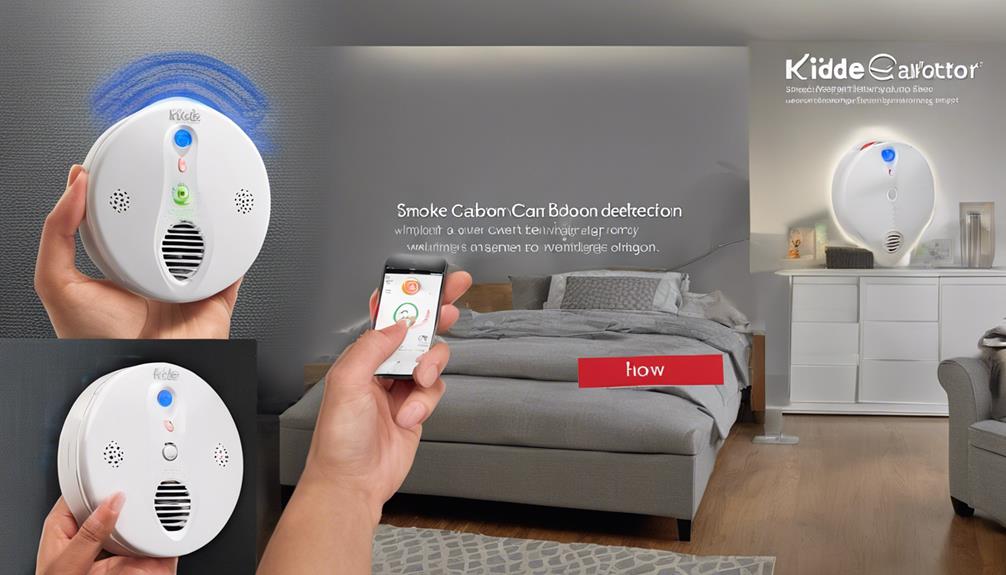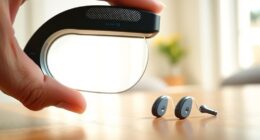For individuals who are deaf, having the appropriate alarms is crucial for fire safety. Our top picks include the Bellman & Symfons Notification System and the Silent Calls Medallion Series Detector.
Curious to discover the other five options that cater to the specific needs of the deaf community? Stay tuned for insights into cutting-edge technology that ensures safety for all.
Key Takeaways
- Alarm systems offer auditory, visual, and tactile alerts for effective notification.
- Specialized alarms detect T3 sound frequency and utilize LED strobe lights.
- Long-lasting battery life of up to 10 years ensures reliable functionality.
- Wireless transmitters extend reach for comprehensive safety in case of fire emergencies.
Bellman & Symfons Notification System
We've found the Bellman & Symfons Notification System to be a comprehensive home protection solution that effectively alerts individuals with hearing loss through auditory, visual, and tactile alerts.
This interconnected system includes a top-of-the-line photoelectric smoke detector for early fire detection. The auditory alerts are loud and clear, ensuring that even those with significant hearing impairment can be warned in case of a fire emergency.
The visual alerts, such as flashing lights, offer an additional layer of notification for those who mightn't hear the auditory signals. Additionally, the tactile alerts, like bed shakers or vibrating pagers, provide a physical sensation to alert individuals who may not see or hear the other notifications.
Silent Calls Medallion Series Detector

Transitioning from the Bellman & Symfons Notification System, the Silent Calls Medallion Series Smoke Detector offers a specialized solution for the hard of hearing with its auditory T3 alarm feature, ensuring effective fire detection.
This innovative detector utilizes a unique radio frequency to prevent false alerts, providing accurate and reliable performance. Moreover, it includes Carbon Monoxide Alarm Transmitters, enhancing comprehensive home safety against fire and gas hazards.
- Cost-effective solution for people with hearing loss
- 3-5 year limited warranty for long-term reliability
- Priced at $110.95, making it an affordable choice
With its advanced features and focus on meeting the specific needs of individuals with hearing impairments, the Silent Calls Medallion Series Smoke Detector stands as a valuable addition to any home seeking enhanced fire detection capabilities.
First Alert Alarm With Strobe Light
The First Alert Alarm with Strobe Light is a crucial safety device for the hearing impaired, offering a visual alert system for smoke or fire detection. Its LED strobe light provides an effective means of notification, ensuring individuals are alerted promptly in case of emergencies.
This alarm's simplicity in installation, combined with its long-lasting battery life, makes it a reliable choice for enhancing safety in homes of deaf individuals.
Strobe Light Effectiveness
The effectiveness of the LED strobe light in the First Alert Smoke Alarm for deaf individuals during emergencies is paramount for ensuring rapid visual notification of potential fires. The bright flashing light serves as a crucial element in enhancing fire safety for individuals with hearing impairments, offering them emergency notifications through visual cues.
Key points to consider regarding the strobe light effectiveness include:
- Provides visual alerts with a bright flashing light.
- Specifically designed for deaf individuals or those with hearing impairments.
- Enhances safety by offering a visual indicator in addition to the audible alarm.
The First Alert Smoke Alarm with LED Strobe Light is a reliable choice for those who rely on visual cues for immediate fire safety notifications.
Installation Simplicity
Effortless setup characterizes the installation process of the First Alert Smoke Alarm with LED Strobe Light, ensuring user-friendly operation for enhanced home safety.
The visual LED strobe light offers reliable alerts for the hearing impaired.
This hardwired alarm can be interconnected with other alarms, creating a comprehensive fire alarm system.
Its simple installation makes it ideal for those seeking a straightforward and user-friendly solution.
With continuous power supply and reliability in mind, this alarm provides peace of mind for homeowners looking to enhance their safety measures.
The First Alert Smoke Alarm with LED Strobe Light combines innovation with practicality to deliver a seamless installation process for those prioritizing home safety.
Battery Life Duration
Transitioning from discussing the easy installation process, let's now explore the impressive battery life duration of the First Alert Smoke Alarm with LED Strobe Light. The alarm offers a remarkable battery life of up to 10 years, thanks to its sealed lithium battery technology, providing long-term protection without the need for frequent replacements.
- Longevity: The sealed lithium battery ensures a reliable performance for up to 10 years.
- Visual Alerts: The LED strobe light feature offers visual alerts, crucial for individuals with hearing impairments.
- Interconnectable: With interconnectable capabilities, this alarm can be part of a comprehensive safety system, enhancing protection for deaf individuals.
Lifetones Bedside Fire Alarm

We've got some key points to cover when it comes to the Lifetones Bedside Fire Alarm.
This alarm system offers visual alerts, making it easier for individuals with hearing loss to notice emergency situations.
Placed conveniently by the bedside, it ensures prompt notification through vibrations, sound, and visual cues for enhanced safety measures.
Visual Alert Options
Visual alert options, such as the Lifetones Bedside Fire Alarm, play a crucial role in ensuring individuals with hearing loss are promptly notified during emergencies by offering visual, vibrating, and sound alerts.
This specialized alarm detects the T3 sound frequency of installed smoke detectors and provides multiple notification methods for fire emergencies. The Lifetones alarm is designed to cater to the specific needs of the hearing impaired, offering an innovative approach to enhancing safety measures.
Bedside Placement Convenience
Continuing our exploration of the Lifetones Bedside Fire Alarm, a key aspect to highlight is its convenient placement by the bedside, ensuring immediate alerts for the hearing impaired during fire emergencies. This specialized alarm system complements existing smoke alarms, offering peace of mind and enhanced safety measures for deaf individuals. With various notification methods like vibration, visual alerts, and sound, the Lifetones Bedside Fire Alarm ensures that individuals are promptly alerted in case of a fire incident. Its strategic design caters to the unique needs of those with hearing loss, prioritizing convenience and accessibility. This innovative addition to home safety measures provides deaf individuals with the protection they need during fire emergencies.
| Convenient Placement | Immediate Alerts | Enhanced Safety |
|---|---|---|
| Strategic Design | Unique Needs | Peace of Mind |
| Accessibility | Prompt Alerts | Protection |
| Prioritizes Safety | Innovative | Reliable Alert |
Vibration for Notification
Regularly detecting the T3 sound frequency of existing smoke alarms, the Lifetones Bedside Fire Alarm provides visual, vibrating, and sound alerts tailored for individuals with hearing loss. This innovative device ensures that hard of hearing individuals or deep sleepers are promptly notified during emergencies through a combination of notification methods.
- The vibration feature is specifically designed to wake deep sleepers who may not be alerted by sound alone.
- Visual alerts add an extra layer of emergency notification for those who may not hear the alarm.
- Sound alerts complement the vibration and visual signals, ensuring multiple ways to grab the attention of individuals with hearing impairment.
Lifetones' unique approach enhances safety measures by offering a comprehensive notification system that complements traditional smoke detectors.
Kidde Smoke & Carbon Monoxide Detector

How does the Kidde Smoke & Carbon Monoxide Detector enhance safety for individuals, including those who are deaf or hard of hearing?
The Kidde Detector is a reliable dual-function alarm that detects both smoke and carbon monoxide, ensuring comprehensive protection.
With a battery backup feature, it operates continuously, even during power outages, enhancing its dependability.
The alarm's voice notifications clearly announce the presence of smoke or carbon monoxide, prompting swift action.
Its interconnectivity allows all interconnected alarms to trigger when one detects a hazard, ensuring everyone is alerted.
Designed to meet safety standards, this detector provides peace of mind for users, especially those who are deaf or hard of hearing.
Serene Smoke Detector With Transmitter

The Serene Smoke Detector, equipped with a wireless transmitter, ensures timely alerts for individuals with hearing impairments during fire emergencies. This specialized smoke detector prioritizes safety and accessibility for deaf people by offering multiple alert options. Here are some key features of the Serene Smoke Detector:
- Visual Alerts: The device emits bright flashing lights to catch the attention of individuals who are deaf or hard of hearing.
- Auditory Alerts: In addition to visual alerts, it also includes a loud alarm sound to alert occupants in the vicinity of the fire.
- Tactile Alerts: For added assurance, the smoke detector comes with a tactile alert feature that vibrates to ensure those with hearing impairments are promptly notified.
With its wireless transmitter extending the reach of the alarm system, the Serene Smoke Detector is ideal for larger homes or spaces, providing peace of mind and enhancing safety for individuals facing hearing challenges during fire emergencies.
Safeawake Smoke Alarm With Bed Shaker

Discussing the Safeawake Smoke Alarm with Bed Shaker enhances awareness and safety for individuals who are deaf or hard of hearing during emergencies. This innovative smoke alarm includes a bed shaker that vibrates vigorously to wake individuals from deep sleep, ensuring they receive immediate emergency notifications.
In addition to the bed shaker, the Safeawake Smoke Alarm provides visual alerts such as flashing lights and sound alerts, offering multiple alert mechanisms for enhanced protection. Designed specifically for those who are deaf or hard of hearing, this device offers a comprehensive safety solution for smoke and fire incidents.
By incorporating both visual and sound alerts along with the bed shaker, the Safeawake Smoke Alarm guarantees that individuals with hearing impairments are promptly alerted in case of emergencies, providing peace of mind and a sense of security.
For individuals seeking an effective and reliable safety solution, the Safeawake Smoke Alarm with Bed Shaker stands out as a vital tool in emergency preparedness.
Frequently Asked Questions
What Kind of Fire Alarm Does a Deaf Person Use?
When we think about fire alarms for deaf individuals, the key feature is alternative alert mechanisms. These alarms incorporate visual, vibrating, and tactile alerts to ensure prompt response during emergencies.
Popular options include LED strobe lights, bed shakers, and smart-home capabilities for enhanced safety.
Do They Make Smoke Alarms for Deaf People?
Absolutely, they do make smoke alarms specifically designed for deaf individuals. These alarms utilize visual and tactile alerts, such as strobe lights and bed shakers, to ensure safety during emergencies.
Traditional smoke alarms may not effectively alert deaf people. Companies like Bellman & Symfons and Silent Call offer specialized smoke alarms with advanced features.
These alarms not only provide safety but also incorporate smart-home capabilities for enhanced protection.
What Alarm Do Deaf People Use?
We use specialized fire alarms with visual, vibrating, and haptic feedback alerts to ensure safety. Features like LED strobe lights, bed shakers, and smart-home capabilities cater to our specific needs.
Lifetone Bedside Fire Alarm and Silent Calls Medallion Series are popular choices. Bellman & Symfons Smoke and Fire Notification System offers interconnected alerts. First Alert Smoke Alarm with LED Strobe Light is a reliable option with visual notification features.
What Is the Most Common Alerting Device for the Deaf?
When it comes to alerting devices for the deaf, the most common choice is a strobe light. These lights provide crucial visual alerts during emergencies, ensuring the safety of individuals with hearing impairments.
Integrated with fire alarm systems, strobe lights offer prompt notifications in homes, public buildings, and workplaces. They're essential for the deaf community, offering a visual alternative to traditional audible alarms in emergency situations.
Which Fire Alarms for Deaf People Offer the Best Features for Safety?
When selecting a smoke detector for the deaf, it’s important to consider models that offer visual alerts such as flashing lights or vibrating pads. Some of the best features to look for include long battery life, connectivity to smart home systems, and multiple alert options for maximum safety.
Conclusion
Just like a lighthouse guides ships safely to shore, these top 7 fire alarms for deaf people serve as beacons of protection in times of emergency.
With their auditory, visual, and tactile alerts, they ensure that no one is left in the dark when it comes to fire safety.
Trust in these devices to sound the alarm and light the way to safety, providing peace of mind for deaf individuals and their loved ones.











